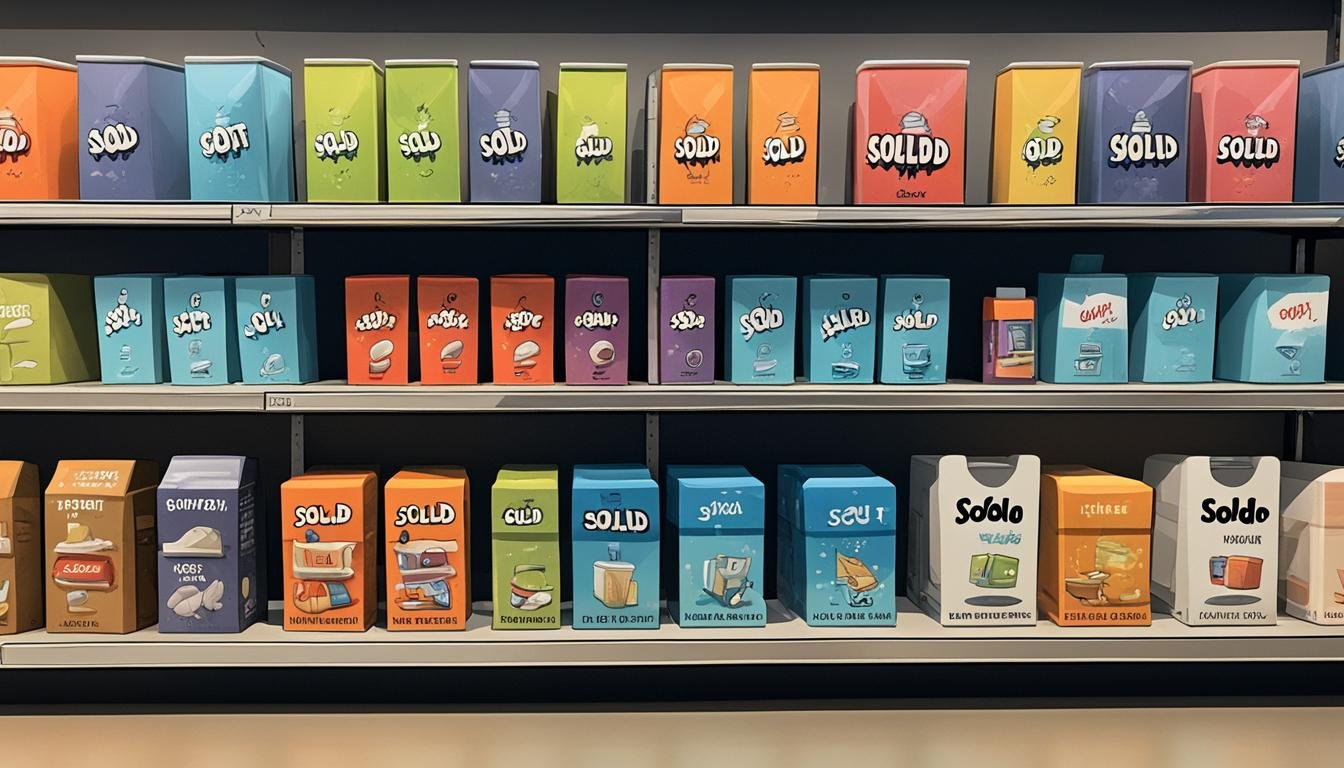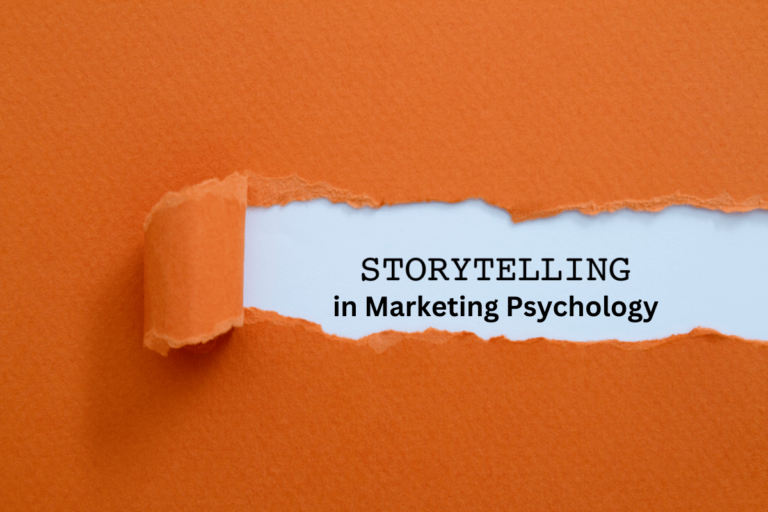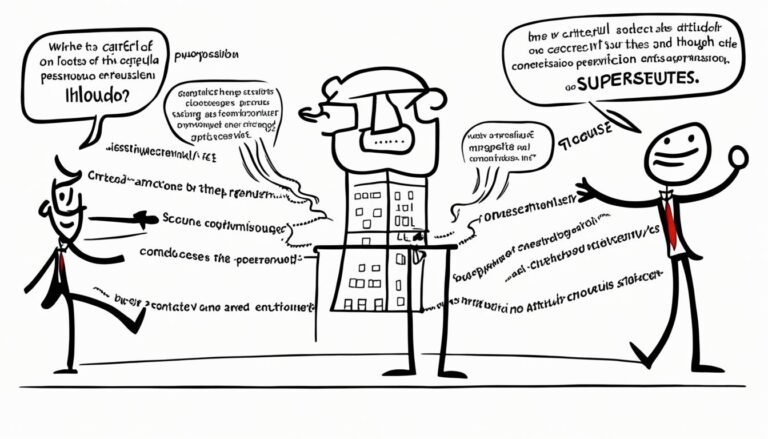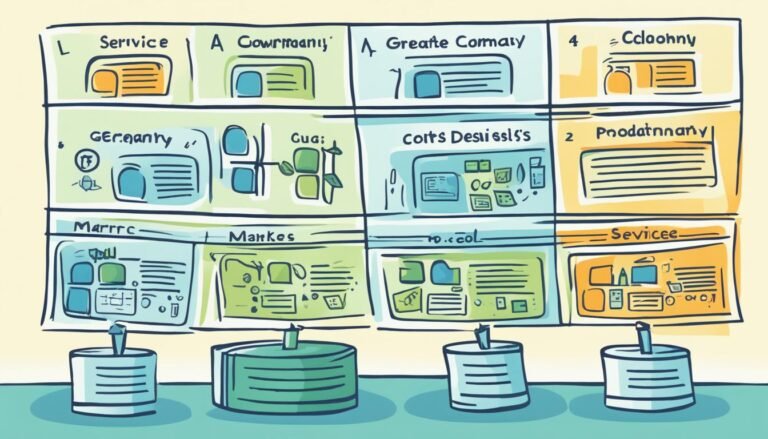Scarcity Principle: Creating Urgency and Desire
Nike gets about 300,000 entries for its limited-edition sneakers on the SNKRs app when they launch a new collection. This shows how powerful scarcity marketing strategies are. Thousands of people rush to buy before the product sells out. The scarcity principle is a key strategy for marketers to make people want to buy more quickly.
Snap Inc. made a big splash with its Spectacles by dropping vending machines in a few US cities. This caused a big buzz that led to a lot of demand. Starbucks’ Unicorn Frappuccino also got over 150,000 Instagram posts in its first week, showing how consumer demand increases when things seem rare.
Big companies like tech giants and coffee chains use the idea of rarity to tap into what people want. Economic studies show that demand goes up when products seem scarce. This is why the scarcity principle is so important in marketing. It makes people feel like they need to act fast, which makes them buy more quickly.
Key Takeaways
- Nike’s SNKRs app receives around 300,000 entries for limited-edition drops, showcasing intense competition and demand.
- Snap Inc.’s limited vending machines for Spectacles spurred excitement and high demand.
- Starbucks generated over 150,000 Instagram posts for the Unicorn Frappuccino, exemplifying how scarcity can drive social media engagement.
- The scarcity principle leverages human psychology to increase urgency and desire for products perceived as rare.
- Effective scarcity tactics, such as exclusive releases and limited-time offers, can lead to significant boosts in consumer demand and sales.
What is the Scarcity Principle?
The Scarcity Principle says that we value things more when they seem hard to get. Dr. Robert Cialdini, a behavioral scientist, found this out. He showed us how our desire grows when things become less available.
Understanding the Basic Definition
In marketing, scarcity means making a product seem rare to create urgency. When people think a product might disappear, they want it more. For example, Apple’s limited iPhone releases cause long lines and high demand.
The Psychology Behind Scarcity
Our brains react strongly to scarcity. It makes us fear missing out (FOMO), leading to quick buys. Marketers use this to make us think we must act fast or miss out. Nike’s limited-edition sneakers sell out quickly because of this.
Examples From Real Life
Supreme is a great example of the scarcity principle. They release new items every Thursday in small amounts, causing instant sell-outs. Luxury brands like Hermès and Chanel also use scarcity to make their products more desirable.
Flash sales and countdown timers are other ways marketers use scarcity. Cracku saw a 300% increase in sales with countdown timers. Booking.com uses limited availability notices to make deals more urgent.
The Law of Supply and Demand
Scarcity is key in shaping *economic supply and demand*. When a product is short and in high demand, prices often go up. This shows how scarcity affects pricing.
How scarcity impacts consumer demand
It’s important to know how scarcity changes consumer behavior. For instance, people often pay more for items that are hard to find, even if similar ones are available. In one study, customers paid 13.29% more for a sunscreen they thought was scarce.
Also, in a high-end beauty store, 37 out of 56 people picked the rarer French soap over another option. This shows how scarcity can make people prefer certain brands or products. In another study, people chose a less known brand, Turion, over Intel when Turion was scarce.
The economic principles at play
Scarcity changes *market dynamics*. When a product is rare, people see it as more valuable, which increases demand. Companies can use scarcity, like limited editions, to make more money. For example, Nintendo’s limited Wii console kept demand high and made more profit.
Scarcity affects how both individual and group consumers behave. It makes people buy quickly, which can boost sales and profits. Scarcity marketing can also lead to higher prices. For example, people might pay up to 50% more for a limited edition product.
The idea that scarcity affects pricing is a big part of economic supply and demand. It makes consumers buy fast, increases the product’s value, and makes it more appealing. By using these strategies, marketers can change market dynamics and how consumers behave.
Psychological Triggers: Fear of Missing Out (FOMO)
Fear of Missing Out, or FOMO, is a psychological trigger used by marketers to make people buy things quickly. It taps into social anxiety and the fear of missing out on something exciting or valuable.
The Role of Social Anxiety
FOMO comes from social anxiety, a deep fear of being left out. People want to be part of trends and experiences shared by others. This fear makes them act quickly when they see others doing something they might not be able to do.
How Marketers Leverage FOMO
Marketers use FOMO to make people buy things fast. For instance, Amazon’s “Today’s Deals” show limited-time offers, making it seem like there’s not much left. Groupon also uses countdowns and shows how many people have already bought something, making people buy quickly.
Case Studies of FOMO in Action
Many brands have used FOMO to increase sales and get more people involved. OnePlus, for example, sold 1 million units and got 25 million website visits with exclusive invites for new products. SushiShop saw a 3% increase in orders by using urgency tactics. Basecamp, a project management tool, shows happy clients to make others feel like they’ll miss out if they don’t join.
Using FOMO in marketing works by playing on people’s desire to not miss out. It makes them act fast and helps build loyalty to a brand. Social proof and making people feel like they have to buy now are key to using this powerful trigger.
Creating Urgency and Desire through Limited Availability
Using the scarcity principle in e-commerce means using strategies to make products seem rare and valuable. This can make customers want them more and buy them faster. It also makes them more loyal to the brand.
Strategies to Display Limited Availability
There are many ways to show that products are limited, making customers feel they must act fast. Using limited-time offers and showing when stock is low are great ways to do this. For example:
- Flash sales make products cheaper for a short time, pushing shoppers to buy right away.
- Exclusive, limited-edition items make people feel special, like with Chanel’s special handbags.
- Showing how many are left on product pages makes people realize they might miss out, speeding up their decision.
Effects on Consumer Behavior
When products are scarce, it changes how people think about buying them. It makes them feel like they’re in a race to get what they want, like with new tech from Apple. This makes them buy quickly to not miss out.
E-commerce scarcity tactics really affect how people decide what to buy. By making things seem urgent, marketers get customers focused on what they want right now. This leads to more sales as people want to get what they can before it’s gone.
Examples from E-commerce
Amazon uses flash sales impact with “Today’s Deals” to make things seem like they’re going fast. Sony and Microsoft do the same with their game consoles, telling customers when they’re running out. This not only increases sales right away but also builds a strong connection with customers.
Also, giving exclusive content to subscribers, like on Netflix, makes them feel they’re getting a special deal. This helps keep customers coming back. These examples show how using scarcity in e-commerce can really make customers want things more.
Using Countdown Timers Effectively
Adding a countdown timer to your marketing can really boost your results, especially for time-sensitive offers. It creates a sense of urgency and makes potential buyers feel like they need to act fast.
The Psychological Impact of Countdowns
A countdown timer makes customers want to act quickly to not miss out. Emails with timers can almost double the number of people who open them, going from 7-17% to nearly 24%. During big sales events like Black Friday, using timers can increase conversions by up to 400%.
Best Practices for Implementation
Here are some tips for using countdown timers well:
- Visibility: Put the timer where everyone can see it, like right at the top. This is key, especially in emails.
- Clarity: Make sure the offer is clear and the timer is believable to keep trust.
- Repetition: Use timers in longer messages to keep the sense of urgency going.
- Mobile Optimization: Make sure timers work well on phones for people checking them on the go.
- Segmentation: Adjust your timing based on who you’re sending it to for better results.
- Ethical Use: Always be honest with your offers and respect people’s privacy.
Following these tips can really pay off, like a 30.49% increase in clicks and a 231% jump in sales. Using countdown timers smartly is a great way to make your scarcity tactics optimization work well.
Exclusivity as a Scarcity Tactic
Exclusivity in marketing taps into our deep desire to belong to special groups. By offering limited editions and scarce products, brands make their items more valuable and appealing. This creates a strong urge for consumers to buy fast, fearing they might miss out.
Brands like Nike and TOMS have used scarcity and exclusivity well to grow their market. For example, Nike only made 100,000 pairs of a new sneaker color. This made people excited and increased demand. TOMS also did well with their limited-edition panda collection, linking it to a good cause.
Scarcity and exclusivity boost consumer actions like higher conversion rates and bigger average order values (AOV). When brands announce exclusive items, they see more clicks and people spending more time on their sites. This was true for Starbucks’ Unicorn Frappuccino and Aldi’s weekly “special buys.”
Exclusivity isn’t just for physical items. SocialCam’s invite-only start got over 16 million sign-ups. JustFab’s VIP program also made shopping more exclusive, building loyalty and value.
Exclusivity doesn’t just boost sales right away. It also builds long-term loyalty. People want to be part of a special group, so they keep coming back. This makes exclusivity key to successful marketing strategies.
Supply and Demand Manipulation
Today’s market is all about supply and demand manipulation. Companies use this strategy to boost sales and make their products more desirable. By controlling supply, they tap into consumer trends and increase product appeal.
Controlling supply to increase desire
Limiting a product’s supply is a key way to make it more wanted. This creates a feeling of urgency and makes the product seem exclusive. As a result, more people rush to buy it before it’s gone.
This method not only grabs attention but also uses our natural fear of missing out to increase sales. It’s a smart way to make products more appealing.
Examples from the tech industry
The tech world is full of examples of how supply and demand work together. Apple and OnePlus are great examples. OnePlus made their phones hard to get, which made them more exciting to tech fans. This made people want them even more.
Nintendo also played this game with their Wii consoles. They only made a few each month, which made them sell out fast. This created long lists of people waiting to buy one.
Tesla’s Model 3 launch is another example. It got over 500,000 pre-orders because it was seen as rare and special. Nike’s SNKRs app also works like this, releasing limited shoes that everyone wants.
These strategies help companies stand out in the market. They make sure both supply and demand work in their favor.
Persuasive Marketing Techniques
Effective persuasive advertising often uses scarcity to get people to act fast. This method taps into psychological triggers to make people feel like they must act now or miss out. It makes offers seem exclusive and urgent.
Leveraging Scarcity in Advertising
Scarcity marketing shines by showing that an offer is limited. Brands make their products seem more appealing by saying there’s high demand and not much stock left. For example, Booking.com does this by showing how many rooms are still available, pushing people to book right away.
A study by Jack Brehm found that when things become scarce, people feel their choices are being threatened. This makes them want the item more. That’s why showing limited quantities often makes people want to buy more.
Creating Compelling Offers
Making compelling sales offers is key in persuasive marketing. Using countdown timers, like on Amazon and TigerDirect.com, creates a sense of urgency. This taps into consumers’ need for quick delivery. In fact, 38% of people say technology has made them less patient, showing the power of urgency in offers.
Scarcity can also be used in emails, like those reminding customers about items they left in their cart. Telling customers there’s only a little stock left can make them finish their purchase. Offers like the Limited-Introductory-Price balance discounts with product quality, pushing people to buy early.
Exclusive offers, like Starbucks’ holiday items or Modcloth’s special holiday designs, add to the sense of exclusivity. These limited-time deals attract customers looking for something unique and rare, boosting sales.
- 38% of people reported that technology has made them less patient.
- Using limited product availability without discounts can create a sense of exclusivity.
- By emphasizing scarcity, opportunities become more desirable due to the perceived threat to freedom of choice.
In conclusion, using persuasive advertising and scarcity in marketing can really boost a campaign’s success. By offering compelling sales offers, brands can get people to act fast, which helps increase sales.
Conversion Optimization through Scarcity
Scarcity is a strong marketing tool that boosts conversion rates when used right. It makes people act fast by making things seem rare or urgent. This leads to more people buying things. Tools like countdown timers and limited stock alerts help marketers push people to buy more.
For example, Amazon uses stock limits and timers to show scarcity. This approach affects how many people buy things.
How scarcity increases conversion rates
Scarcity really helps in making more people buy things. Setting deadlines for offers can make people buy up to 33% more. Words like “now,” “hurry,” and “instant” push people to buy right away.
Colors matter too. Red, orange, and yellow are linked to urgency and can make more people buy. For example, SAP BusinessObjects saw a 32.5% jump in sales by using an orange button instead of blue text.
Neil Patel uses orange and yellow buttons on his sites to get more people to buy.
Tools and methods for measuring success
It’s key to check how well scarcity works for marketing. Marketers can use A/B testing, analytics, and surveys to see what works best. A/B testing lets marketers test different scarcity methods to find the best ones.
Analytics track how people act and how many convert, showing the effect of scarcity. Surveys give feedback on how scarcity affects buying decisions. By using these tools, businesses can keep improving their marketing to get more sales without losing their brand’s value.
Source Links
- The Scarcity Principle: How 7 Brands Created High Demand
- Scarcity Principle: Definition, Importance, and Example
- What Is Scarcity Principle? | Applications & Impact on Consumer Behavior
- The Scarcity Principle: How 3 Brands Generated High Demand
- While Supplies Last: 8 Scarcity and Urgency Tips for Stores (2023) – Shopify
- 34 Real-World Scarcity Examples to Boost Website Conversions
- Scarcity – Everything You Need to Know
- The effects of scarcity on consumer decision journeys
- 5 Clever Scarcity and Urgency Examples to Boost Your Conversions
- FOMO in Marketing: Scarcity Sells | Mailchimp
- How Scarcity Drives Customer Behaviour – Richard Batt
- How Scarcity and Urgency Fulfill Basic Needs and Desires – Freedom to Ascend
- Scarcity and Exclusivity: Creating Urgency and Desirability
- Do countdown timers even work? Understanding urgency in 2022
- What Are Countdown Timers? | Impact on Consumer Behavior & Best Practices
- How to use scarcity and urgency tactics for increased conversions
- 7 Brands That Leveraged Scarcity Marketing Tactics to Win More Customers – Digital Marketing Agency NJ & NYC
- 7 Ecommerce Scarcity Marketing Tactics to Supercharge Sales
- The gentle science of persuasion, part six: Scarcity
- How Your Business Can Use Scarcity Marketing To Increase Sales – crowdspring Blog
- Scarcity Marketing: 6 Innovative Tactics You Need to Know (+ Examples)
- A Primer on Persuasive Marketing Techniques [Updated]
- 19 Examples of the Scarcity Principle Used in Marketing
- How to Use Urgency and Scarcity to Improve Conversions
- The role of scarcity and urgency in conversion rate optimization
- How To Use Urgency Words To Improve Your Conversions







